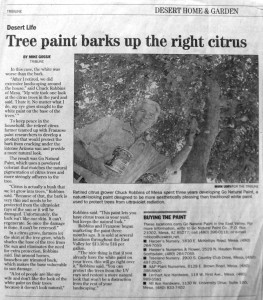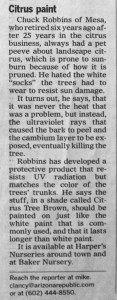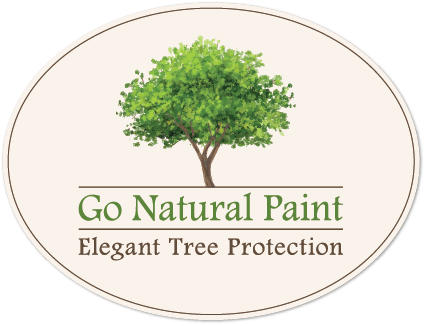People are talking about Go Natural Paint™…
As heard on Rosie on the House with Jay Harper of Harper’s Nursery:
- www.rosieonthehouse.com/faqs/do-i-need-to-worry-about-the-bark-that-is-cracking-and-splitting-away-from-the-trunk
- www.rosieonthehouse.com/faqs/when-is-the-best-time-to-prune-citrus-trees
- www.rosieonthehouse.com/radio/day-with-a-painter
- www.rosieonthehouse.com/radio/navigating-real-estate
Sunset magazine
November, 2002
http://www.sunset.com/garden/garden-basics/natural-looking-paint-citrus-trunks-00400000021868/
Tree Paint Barks Up The Right Citrus
By Mike Gossie
East Valley Tribune
[Transcribed]

In this case the white was worse than the bark.
“After I retired, we did extensive landscaping around the house,” said Chuck Robbins of Mesa. “My wife took one look at the citrus trees in the yard and said, ‘I hate it. No matter what I do my eye goes straight to the white paint on the base of the tree.’”
To keep peace in the household, the retired citrus farmer teamed up with Franzese paint researchers to develop a product that would protect the bark from cracking under the intense Arizona sun and provide a more natural look.
The result was Go Natural Paint, which uses a powdered colorant that matches the natural pigmentation of citrus trees and more strongly adheres to the tree.
“Citrus is actually a bush that we let grow into trees,” Robbins said. “Because of that, the bark is very thin and needs to be protected from the ultraviolet rays of the sun or it will be damaged. Unfortunately, the bark isn’t like our skin. It can’t regenerate. So once the damage is done, it can’t be reversed.”
In a citrus grove, farmers let the skirt of the tree grow which shades the base of the tree from the sun and eliminates the need for extra protection, Robbins said. But around homes, branches are trimmed back, which makes the base vulnerable to sun damage.
“A lot of people are like my wife and don’t like the look of the white paint on their trees because it doesn’t look natural,” Robbins said. “This paint lets you have citrus trees in your yard, but keep the natural look.”
Robbins and Franzese began marketing the pint three months ago. It is sold at several locations throughout the East Valley for $13.50 to $16.00 per gallon.
“The nice thing is that if you already have the white paint on your trees this will go right over it,” Robbins said. “You can protect the trees from the UV rays and restore a more natural look that won’t be a distraction from the rest of your landscaping.”

Garden Q&A
John Chapman
East Valley Tribune, September 22, 2001
[Transcribed]
Oozing orange trees can be treated
Q: I have a Valencia orange tree where several small branches have brown sections with crystallized “stuff” on them. The section beyond the brown area, which is about two-thirds of the thickness of the branch in that little area, is still green What is the problem (a borer?), and should I cut off these branches? I haven’t noticed this problem on the other citrus trees.
A: The symptoms you have described – the crystallized brown ooze – sound very much like gumosis. Here is the treatment recommended by Chuck Robbins, a retired citrus farmer. Using a sharp knife, cut away the crystal an ooze, looking for a hole int he bark where the fluid seeped out. Cut away the bark as far back as the liquid is showing and wash the area with water using a soft brush. From Bourdeaux mix, which you can buy at nurseries, make a poultice the consistency of putty and pack the area. Paint over the packing paste with Go Natural Citrus Paint. If another ooze erupts from the same area, repeat the process. It may take a couple of treatments to be effective.
I have seen several trees that had the whole side of the tree with this brown oozing and dried brown crystallized balls hanging to the bark. After Chuck’s treatment, almost all of it stopped. A couple of places had to have a second treatment to completely shut down the weeping. This is not a cure – there is no cure – but you can put the gumosis into remission and slow down the decline of the tree, thus prolonging its life by several years.
Citrus Paint
The Arizona Republic, June 20, 2001
[Transcribed]

Chuck Robbins of Mesa who retired six years ago after 25 years in the citrus business, always had a pet peeve about landscape citrus, which is prone to sunburn because of how it is pruned. He hated the white “socks” the trees had to wear to resist sun damage.
It turns out, he says, that it was never the heat that was a problem, but instead the ultraviolet rays that caused the bark to peel and the cambium layer to be exposed, eventually killing the tree.
Robbins has developed a protective product that resists UV radiation but matches the color of the trees’ trunks. He says the stuff, in a shade called Citrus Tree Brown, should be painted on just like the white paint that is commonly used and that it lasts longer than the white paint.
It is available at Harper’s Nurseries around town and at Baker Nursery.




